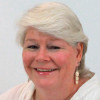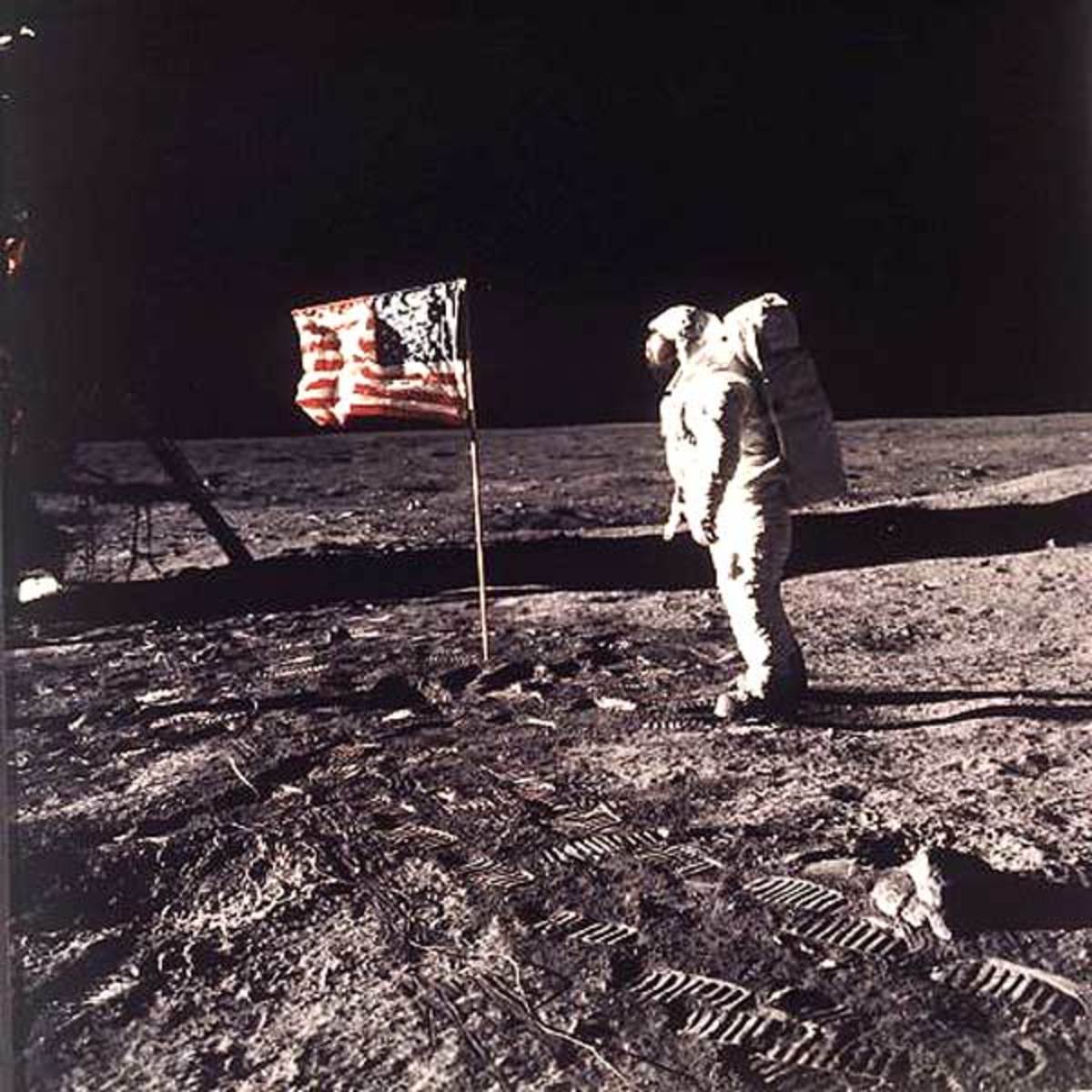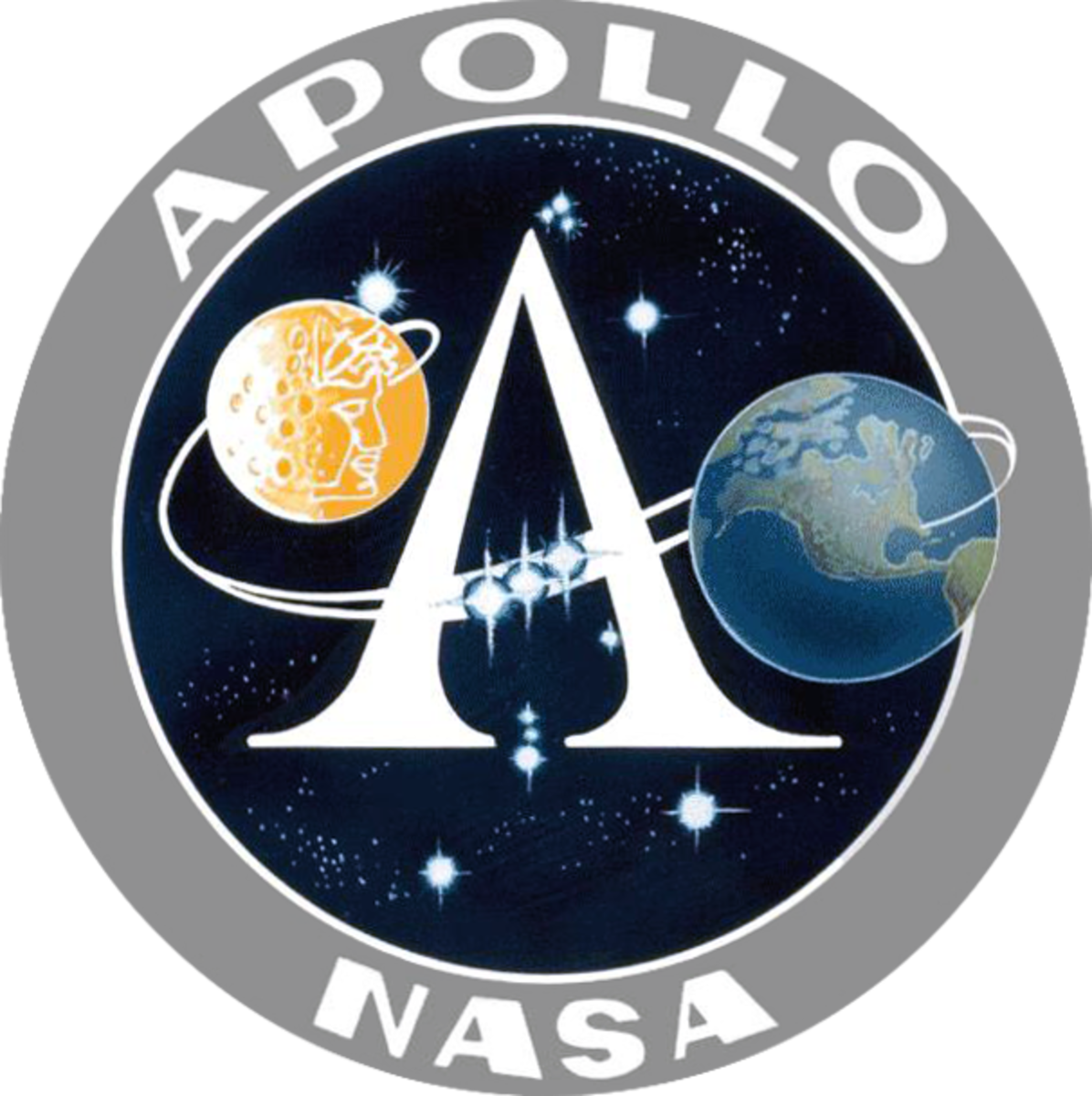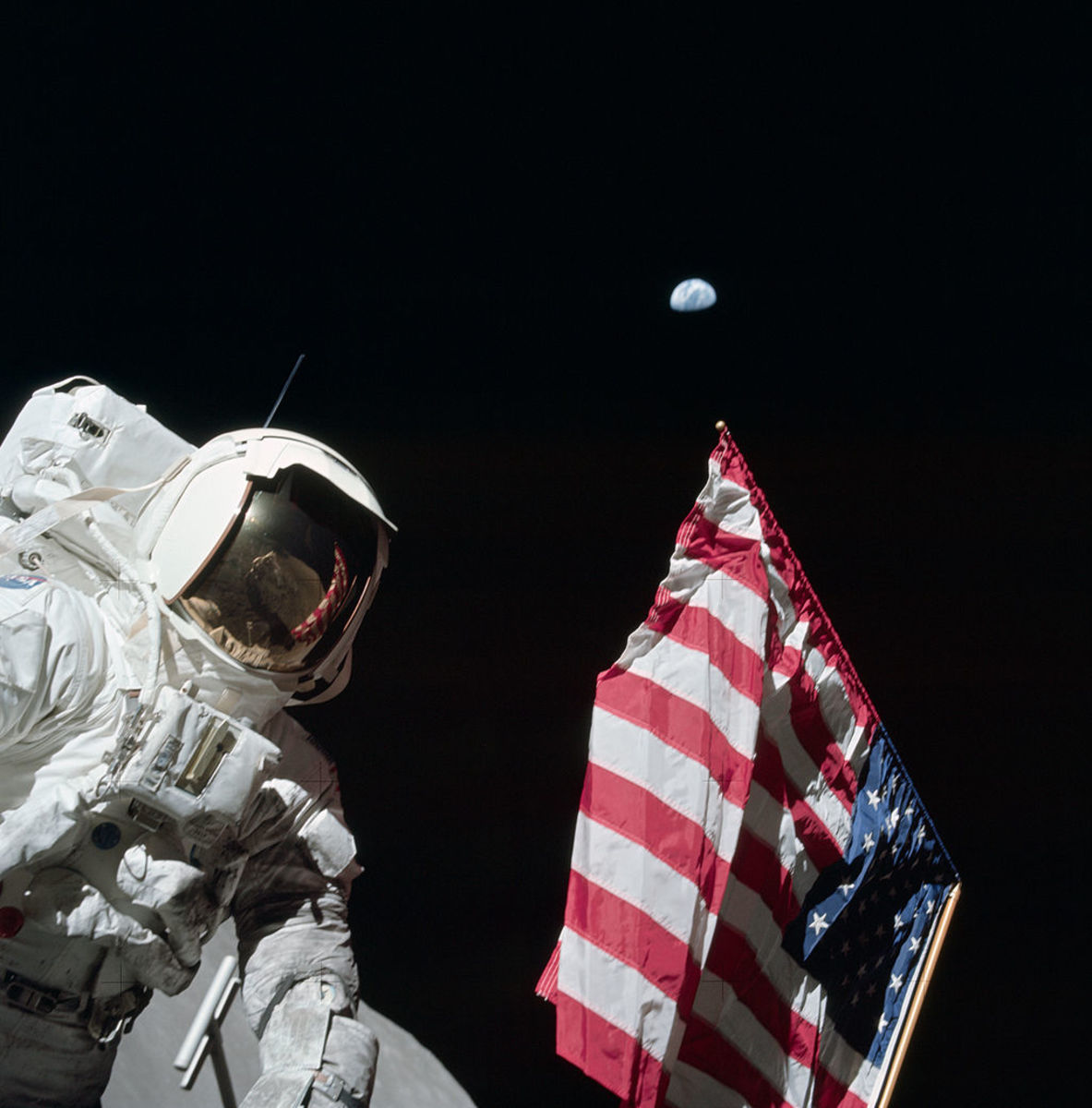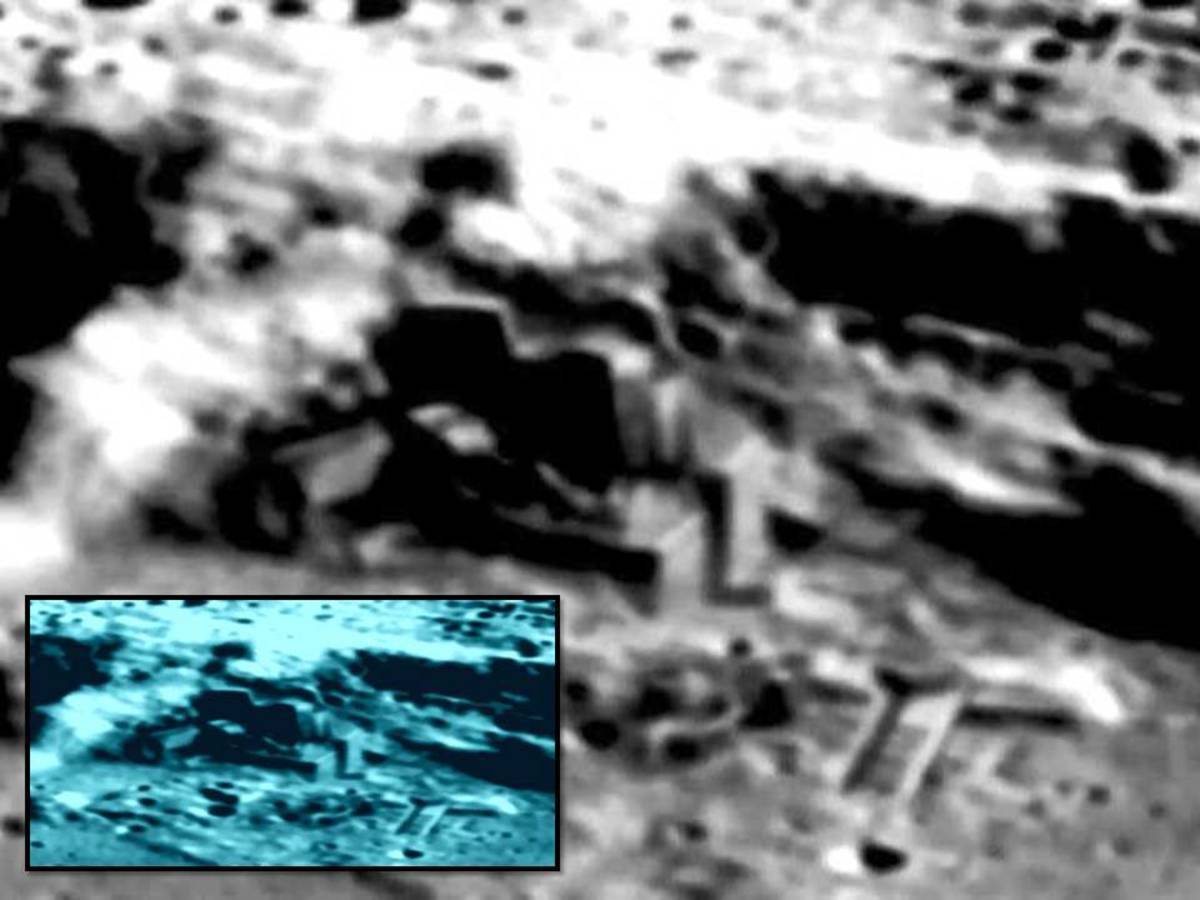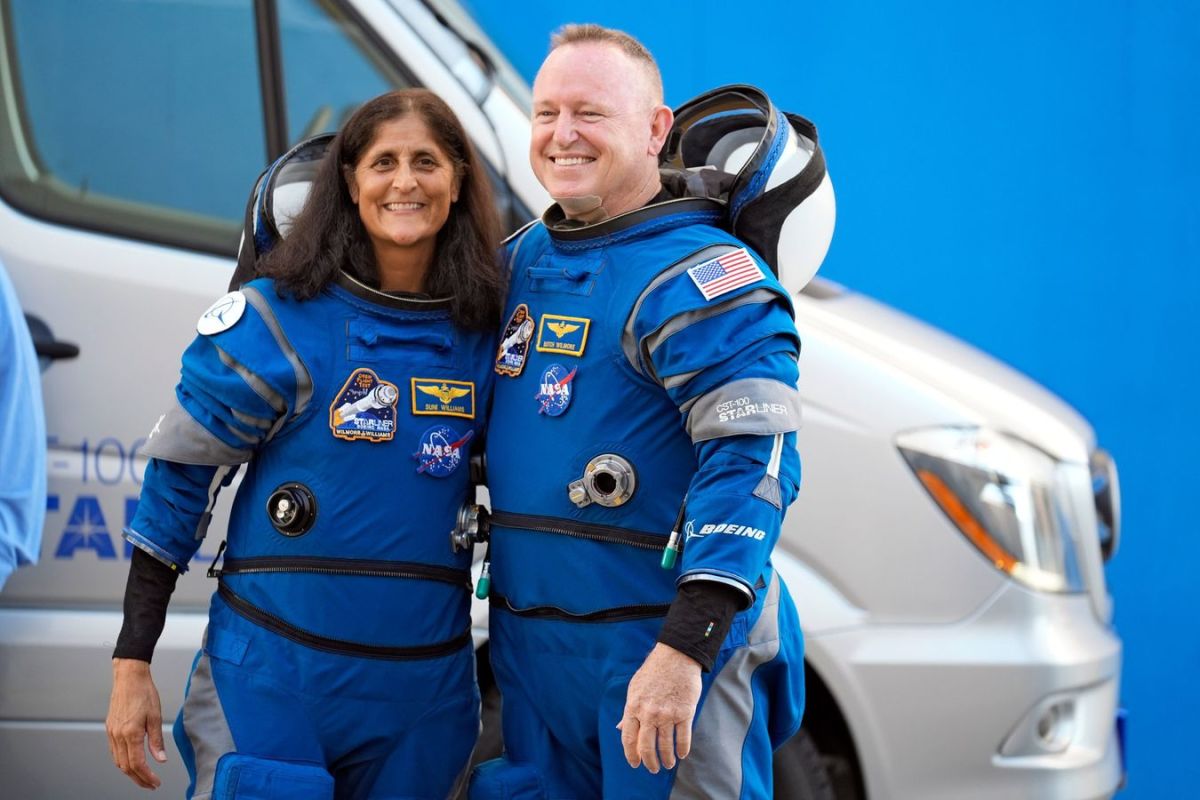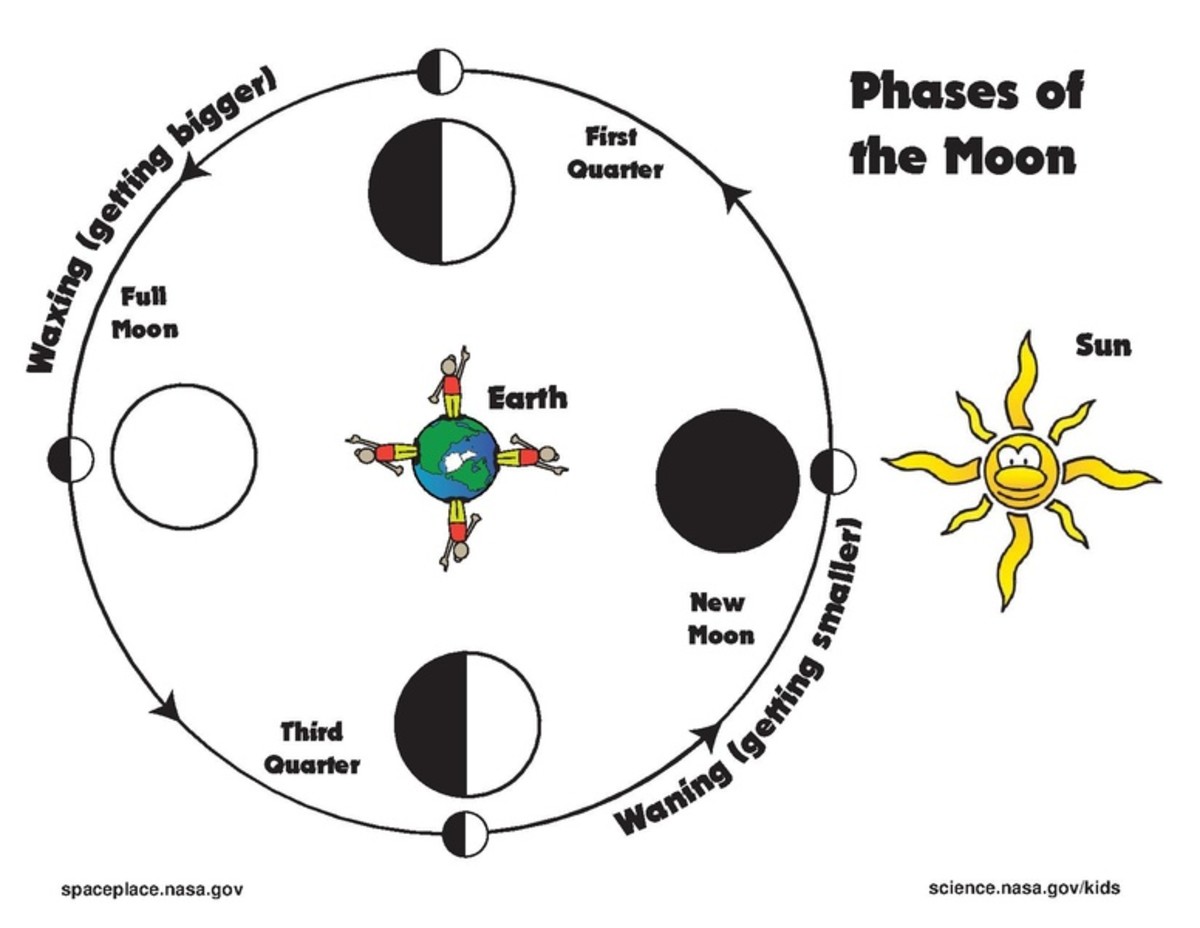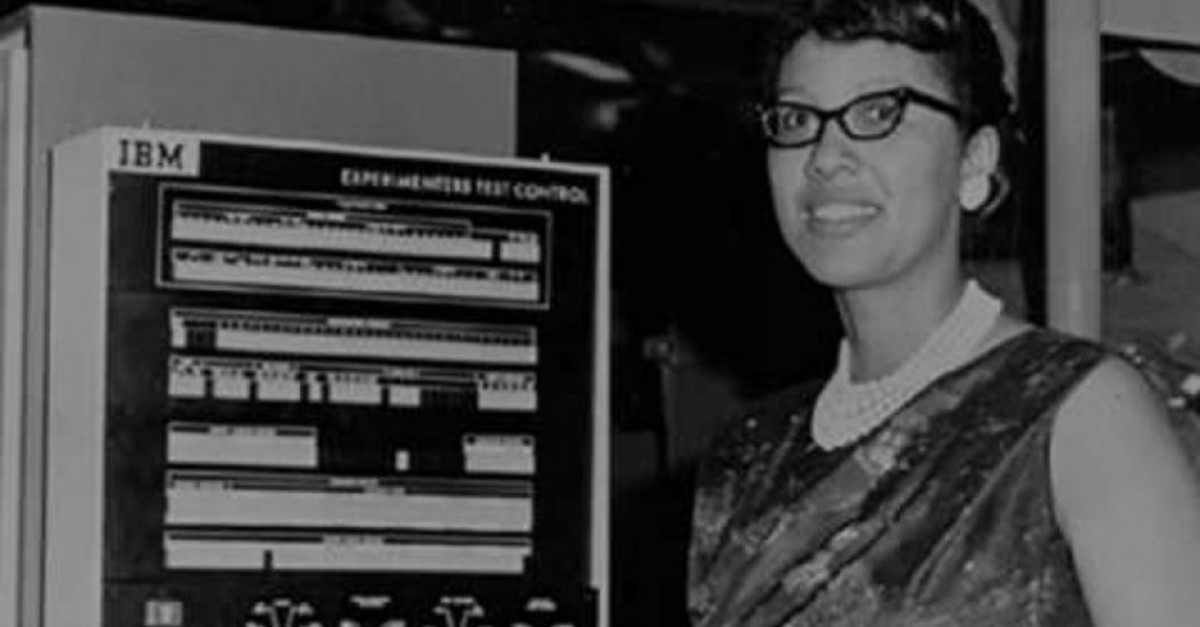Moonwalks, Moonwalkers and Moonwalk Videos (The Men Who Walked on the Moon Part 2)
Neil Armstrong - NASA's First Lunar Lander!
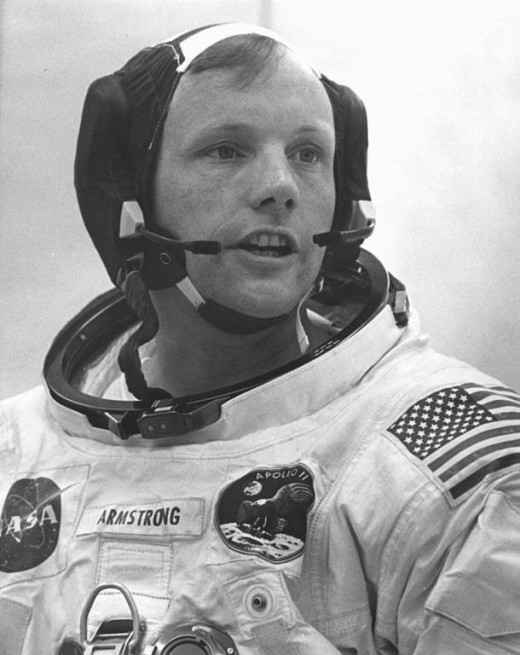
The Daring Dozen - NASA's 12 Men on the Moon
Of the 38 astronauts in the Apollo Space program, only 12 ever set foot on the moon. Here's the list - and below you'll find the story of their moonwalks and their moonwalk videos! Plus a range of moon landing memorabilia and the best books to read about these amazing NASA astronauts.
- Neil Armstrong
- Edwin "Buzz" Aldrin
- Charles "Pete" Conrad
- Alan Bean
- Alan Shepard
- Edgar Mitchell
- David Scott
- James Irwin
- John Young
- Charles Duke
- Eugene Cernan
- Harrison Schmitt
If you missed part 1 of this story, check it out here:
Why should you care? Take a step back in time. Remember sitting in grade school watching the moon landings or the space shuttles lifting into the sky? If you are like many, you remember these things because they were so big at the time. Why not step back in time just a bit and learn about this landings again? It is a part of our history and something you should be proud of being a part of, too.
Neil Armstrong during suitup for Apollo 11
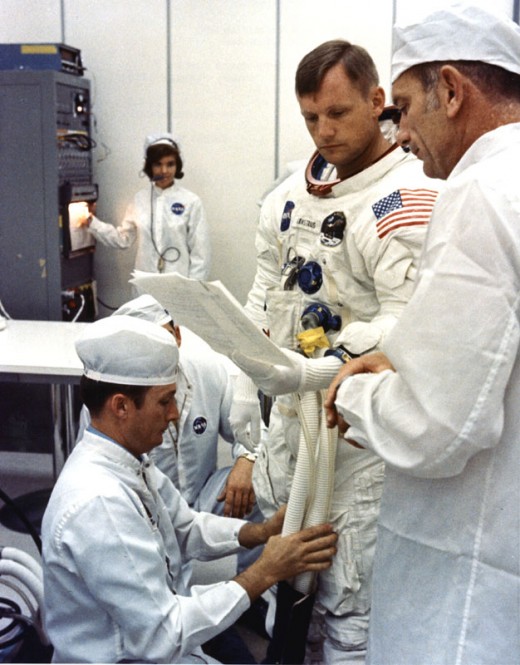
Neil Armstrong - 1st Man on the Moon
As mentioned, Neil Armstrong was a crew member on the Apollo 11 and holds the distinction of being the first man to walk on the moon in July 1969. He spent 2 ½ hours on the surface of the moon.
Born in 1930, Neil Armstrong earned degrees from Purdue University and the University of Southern California. Armstrong is a Korean War veteran and served in the United States Navy as an aviator. After the war he became a test pilot. His first venture into space was on the Gemini 8 in 1966.
After the Apollo 11 flight, Neil Armstrong announced he would not fly into space again. At that point he started a new career as an aeronautical agency administrator and then professor at the University of Cincinnati.
He remained involved in the space program though and participated in the NASA investigation of the Apollo 13 and Space Shuttle Challenger disasters.
Neil Armstrong retired from NASA in 1971.
In the subsequent years he has served on the boards of many private corporations and on government committees as requested.
His experience is outstanding. Take a closer look. This included experience on the National Advisory Committee for Aeronautics. This organization was in place prior to NASA itself. There, he was a research pilot at the Lewis Laboratory in Cleveland, Ohio. He later transferred to NACA High Speed Flight Station, which was located in California, at the Edwards Air Force Base. He tested an outstanding number of new flight technologies, including on high speed aircraft that took him to 4000 miles per hour, the MPH x 15. In fact, he says he has flow in a large number of flying aircraft, including more than 200 different models of jets, gliders, helicopters and rockets.
Also notable about Neil Armstrong was that he earned a variety of special honors. This includes the Presidential Medal for Freedom that he earned in 1969. He then earned the Robert J. Collier Trophy in the same year. He also earned the Robert H. Goddard memorial Trophy a year later. Later on, in 1978, Armstrong would earn the Congressional Space Medal of Honor, a prestigious award.
Neil Armstrong Moonwalks
Buzz Aldrin Moonwalk

Edwin “Buzz” Aldrin - 2nd Man on the Moon
Edwin “Buzz” Aldrin is the second man to walk on the moon following right after mission commander Neil Armstrong on the Apollo 11 mission. Born in 1930, he had a distinguished career as an American aviator and astronaut. He piloted the Lunar Module during the historic space mission.
Buzz Aldrin was a career military man who graduated from the US Military Academy at West Point. He preferred his nickname “Buzz” which resulted from a younger sister’s mispronunciation of the word “brother” as “buzzer”. In fact, Buzz became his legal first name in 1988. He was a Second Lieutenant in the US Air Force and served as a jet fighter pilot. Aldrin served with distinction during the Korean War.
Buzz Aldrin retired from active military duty in 1972 but remained involved in the NASA program.
Take a closer look at some of his experience. Before he joined NASA, Aldrin flew 66 combat missions for the United States during the Korea War, all on F 86's. During this time, he shot down to MIG 15 aircraft in a USAF jet fighter. Later, he served as an aerial gunnery instructor, while he was stationed at the Nellis Air Force Base in Nevada. His flying career did not stop there, of course. He would go on to fly F 100's. He did this as a flight commander at Bitburg, Germany.
During this time, Aldrin was also learning. He received a doctorate at MIT. He later went to Los Angeles, California where he was assigned to the Gemini Target Office. This is a part of the Air Force Space Systems Division. He would spend a total of 21 years working for the country in these various ways before he retired.
Retiring from the NASA was not enough to stop him, though. Aldrin continued on to author a book called Return to Earth. He also remained a role player in various aspects during the years following. Aldrin continued to work for and encourage the continued exploration of space. He now does lectures around the world trying to educate the world on the future of space technology and people. Another book written by Aldrin is called "Men from Earth." Today, Buzz Aldrin, is President of Starcraft Enterprises, a company based out of Laguna Beach, California.
As one of America's most well known and respected space pilots and war heroes, Buzz Aldrin has earned a number of different awards and recognitions. This includes the Presidential Medal for Freedom. He earned this in 1969. Two years prior to this, he earned several awards, including the Robert J. Collier Trophy, the Harmon International Trophy and the Robert H. Goddard Memorial Trophy. He is also a decorated war hero.
Edwin Buzz Aldrin
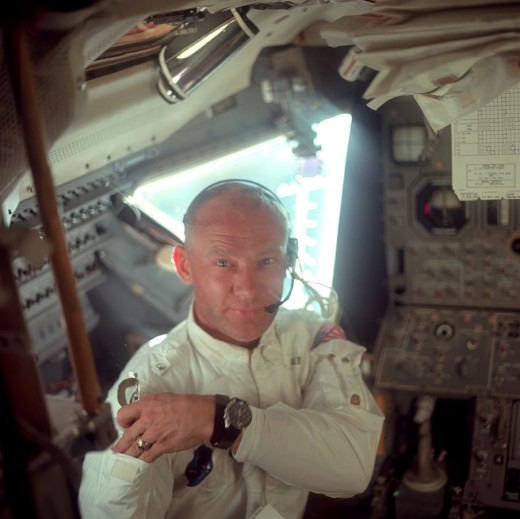
Buzz Aldrin Moonwalks
Charles Pete Conrad
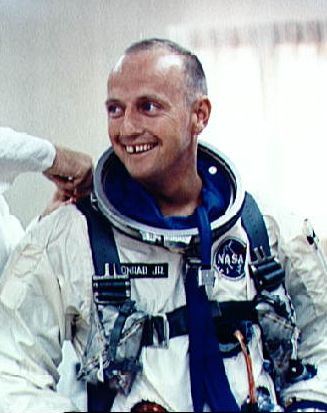
Charles Peter Conrad - 3rd Man on the Moon
Charles “Pete” Conrad was the third man to walk on the moon. He was the commander of the Apollo 12 mission in 1969. Born in 1930, he passed away in July, 1999. He earned a Bachelor’s Degree in Aeronautical Engineering from Princeton University after which he joined the Navy.
Pete Conrad claimed the honor of being the first man to dance on the moon. He was involved in a number of NASA missions including the Gemini 5, precursor to the Apollo program, Apollos 11 and 12, and the Skylab 2 mission. His NASA career began in 1962 and his last mission was as commander of Skylab 2.
During his life, he was much more than just the third man on the moon. He entered the Navy to become a naval aviator. He attended the Navy Test Pilot School out of Maryland and later was assigned to Project Test Pilot. He would later teach as a flight instructor and work as a performance engineer out of the school. He then had a tour of duty at Patuxent River. He went on to serve as an instructor pilot using the top of the line F4H Phantoms on VF 121. After this, Conrad was assigned to the USS Ranger, to manage VF 96's.
He became a US NASA astronaut in September of 1962. On board his first flight, the Gemini V, he established the space endurance record. He was, at the time, the man that spent the most man hours in space. He also set the world's altitude record.
After retiring from NASA, after serving more than 20 years to the country, Conrad accepted a position as the Vice President and Operations and Chief Operating Officer of American Television and Communications Corporation, more commonly known as ATC. He worked as a consultant for the McDonnell Douglas Corporation later and became the Staff Vice President in 1990.
During his lifetime, Conrad earned a large number of awards. One of them was the Congressional Space Medal of Honor earned in October of 1978. He also received two NASA Distinguished Service Medals, Navy Astronaut Wings, two Distinguished Flying Crosses, and two NASA Exceptional Service Medals, among the dozens of others.
Charles Peter Conrad Moonwalks
Charles Conrad Moonwalk
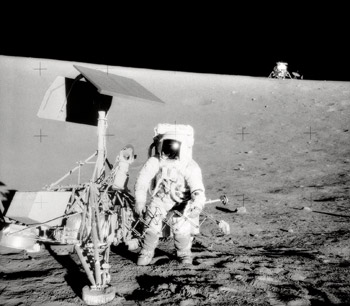
Alan Bean during suitup on launch day
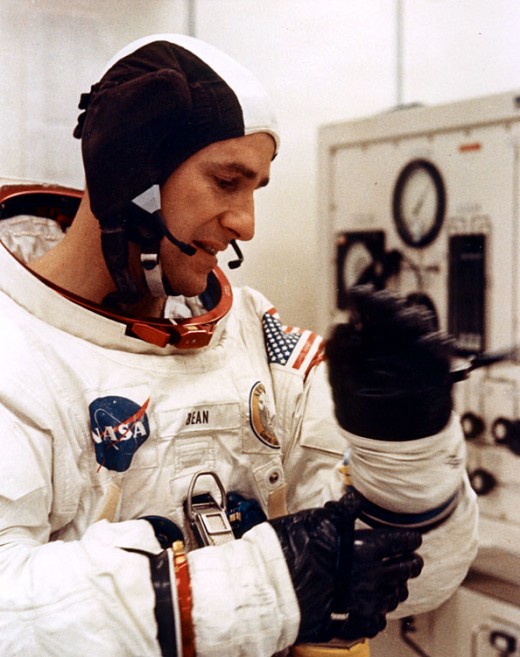
Alan Bean - 4th Man on the Moon
Alan Bean was born in 1932 in Texas. He attended the University of Texas at Austin and trained as a Navy Test Pilot. He began his space training with NASA in 1963 and eventually was chosen as the lunar pilot for Apollo 12. He was the fourth man to walk on the moon.
Alan Bean was instrumental in saving the Apollo 12 mission after the spacecraft was hit by lightning a mere 36 seconds after take-off. He performed a repair which restored telemetry and enabled the mission to continue. He was the astronaut who completed the installation of the first nuclear power generator on the moon which provided a power source on the surface.
Alan Bean also commanded the Skylab 3 in 1973 and participated in the Apollo-Soyuz Test Project. Retiring from the Navy in 1975 he continued to work with the NASA space program. He then resigned from NASA in 1981 and became a full-time artist.
Let's take a closer look at who this man was as part of NASA. Bean was one of the third group of astronauts (the first people to be a part of the organization!) in October of 1963. He was a backup astronaut for the Gemini 10 and Apollo 9 missions. As Captain, he was a lunar module pilot on the famed Apollo 12 mission. In addition, in November of 1969 he also became one of the first to land on the moon. He and Captain Pete Conrad landed in the moon's Ocean of Stormsafter. This flight was more than 250,000 miles long. When there, the two explored the surface of the moon and used various surface instruments to conduct experiments. He also installed the first nuclear power generator station on the surface of the moon. This provided power to the mission.
During his time as spacecraft commander of the Sklylab Mission II, he would spend a 59 day, 24,400,000 mile flight, a world record at the time. The mission was so successfully that it accomplished 150 percent of its pre mission forecast goals. later, he would service as a flight crew member for the joint American Russian Apollo Soyuz Text Project.
In his lifetime as a member of NASA, he logged 1671 hours and 45 minutes of time in space. Of that, 10 hours and 26 minutes was spend in EVAs on the moon itself and in earth orbit.
He flew more than 27 types of military aircraft in is lifetime, as well as numerous civilian airplanes. With more than 7145 hours of flying time, including 4890 hours in jet aircraft, he is one of the most impressive of pilots still. He retired from the Navy in October of 1975 but is still the head of the Astronaut Candidate Operations and Training Group that is part of the NASA, he works in a civilian capacity there.
He, too, has received numerous awards for his service, including for the 11 world records he established in both astronautics and in space travel. He also received two Distinguished Service Medals, two Navy Distinguished Service Medals, and the Navy Astronaut Wings. He also received the Rear Admiral William S Parsons Award for Scientific and Technical Progress.
Alan Bean Moonwalking - destroying the video footage!
Alan Bean steps onto the Moon
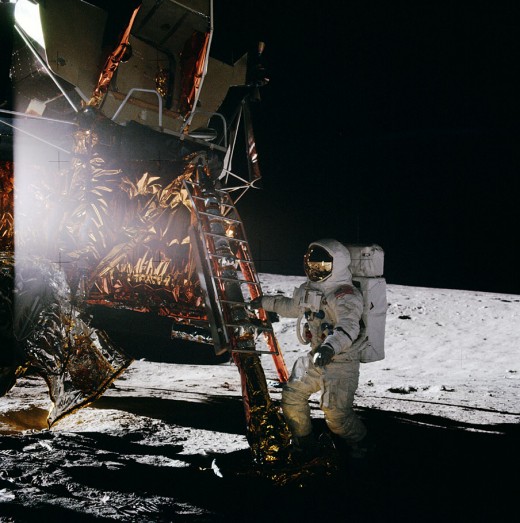
Alan Bean holds a lunar sample container during Apollo 12's second moonwalk.

Alan Shepard
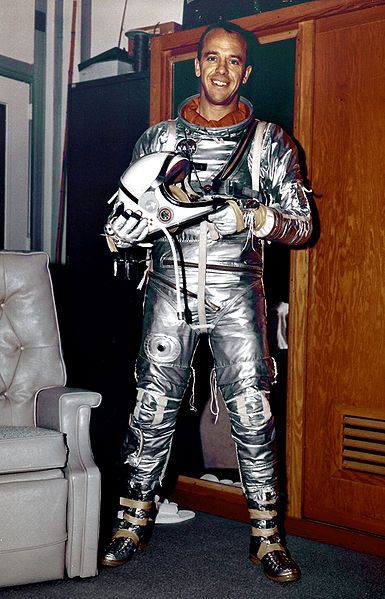
Alan Shepard - 5th Man on the Moon
Alan Shepard was the fifth man to walk on the moon on Apollo 14 in 1971. He was supposed to have been on the ill-fated Apollo 13 which had been destroyed by fire. An ear problem kept him out of the space program for most of the 1960s and the 1970 Apollo 13 mission was to be his first space flight upon return. He decided he needed more training and so did not accept the Apollo 13 mission.
Born in 1923, Alan Shepard died in 1998. He was a graduate of the United States Naval Academy and served during World War II. After the war, he completed flight training and became a carrier fighter pilot.
Alan Shepard was the first American to complete space travel in 1961 on the Freedom 7. In 1963 he became the Chief of the Astronaut Office with NASA. In 1969 he re-entered the space program after corrective surgery on his ear. He was the oldest astronaut in the program when he flew on Apollo 14. Pictures of the trip show include Shepard playing golf on the moon.
Shepard retired from the Navy and NASA in 1974.
Let's take a closer look at Shepard's career. As mentioned, he was one of the Mercury astronauts named by NASA in April 1959. This gave him the ability to say he was the first American to get into space. On May 5th, in 1961, he was on the Freedom 7. It launched by the Redstone vehicle on a ballistic trajectory suborbital flight. On this flight, Shepard rose to 116 statute miles and it landed him at point 302 statute miles down the Atlantic Missile Range.
As the Chief of the Astronaut Office, he had the job of managing the coordination, scheduling and the control of all astronauts with NASA. He was key to developing the training programs that would ensure that pilots and non pilots were able to take on the missions. He was a key component to the program during its early years.
He was on board the Apollo 14 mission from January 31st through February 9th, 1971. He was on this lunar mission with Stuart A Roosa and Edgar D Mitchell. While on the moon, they moved the lunar module, Antares, to land on the upland region of Fra Mauro. They then used scientific equipment and experiments. They brought come about 100 pounds of lunar samples during that mission. This mission was one of the most successful. In it, the following was accomplished by the team:
- It was the first time that the Mobile Equipment Transporter, or MET would be utilized.
- The mission had the largest payload placed in orbit around the moon.
- It was the longest distance traversed on the moon's surface to date.
- It was the largest payload returned from the surface of the moon.
- The 33 hours spent on the surface as the longest time spent there to date.
- It was the longest lunar surface EVA, which was 9 hours and 17 minutes.
- This was the first time the shortened lunar orbit rendezvous techniques were used.
He spent a total of 216 hours and 57 minutes in space. He later would resume his duties of Chief of the Astronaut Office in June of 1971.
Alan Shepard Moonwalks - and Moongolfs!
Alan Shepard on the lunar surface for his Moonwalk
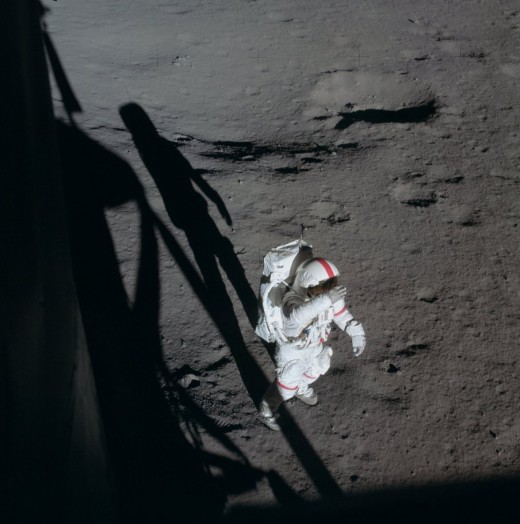
Close-up of Mitchell pulling a training version of the MET while aboard a KC-135
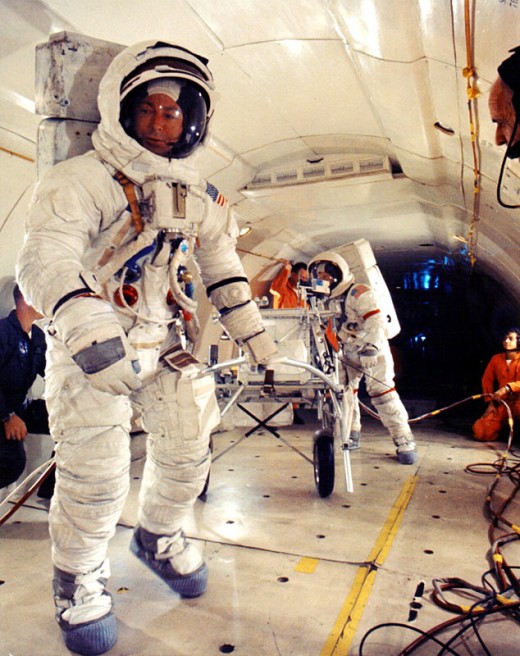
Edgar Mitchell - Sixth Man on the Moon
Edgar Mitchell was the 6th man to walk on the moon during the Apollo 14 space mission in 1971. This was the third NASA crewed moon landing. Born in 1930 he was a graduate of the Carnegie Institute of Technology. After graduating he became a carrier fighter pilot in the Navy while also earning advanced degrees including a doctorate from the Massachusetts Institute of Technology.
Edgar Mitchell is known as one of the astronauts most personally touched by the experience of walking on the moon. After retiring from the Navy in 1972, he founded the Institute of Noetic Sciences. The purpose of the Institute is to study the nature of consciousness. He is also interested in studying psychic and paranormal activities.
Lunar Module Pilot Edgar Mitchell

A technician adjusts David Scott's spacesuit during Apollo 15 prelaunch preparations. July 26, 1971

David Scott - Seventh Man on the Moon
David Scott was the 7th man to walk on the moon during the Apollo 15 flight in 1971. Born in 1932 in Texas, he graduated the West Point Naval Academy in 1954. Scott joined the Air Force and earned degrees in aeronautical engineering from the Massachusetts Institute of Technology.
David Scott’s first space travel was on the Gemini 8 with Neil Armstrong. He was the command module pilot for Apollo 9 and became the last man to fly solo on a space mission. Scott was responsible for conducting scientific experiments on the moon during the Apollo 15 mission.
Now retired from the Air Force, David Scott lives a quiet life in California.
David Scott Moonwalks and the live Hammer and Feather Experiment
Dave Scott on LRV prior to EVA-2 traverse
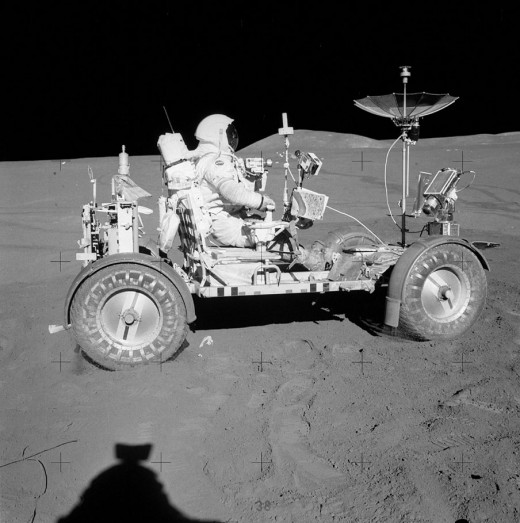
James Irwin
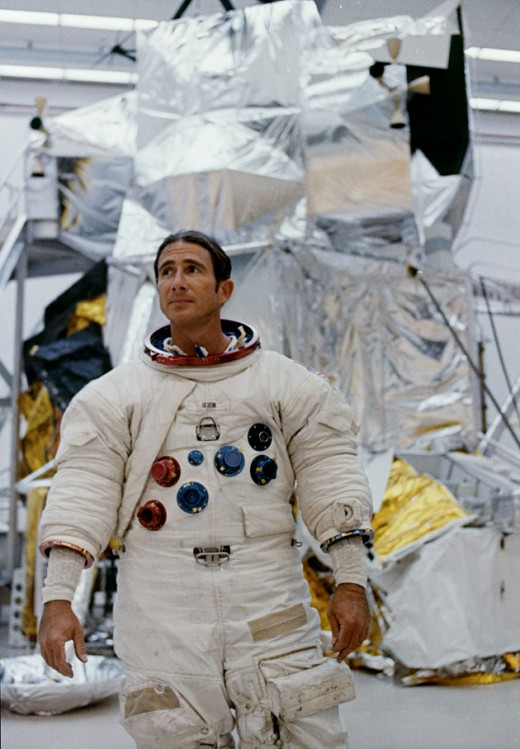
James Irwin - Eighth Man on the Moon
James Irwin was the 8th man to walk on the moon on the Apollo 15 mission. He was born in 1930 in Pennsylvania and died in 1991. He earned a Bachelor of Science degree at the United States Naval Academy and graduate degrees from the University of Michigan.
James Irwin was a trained test pilot for the US Air Force. After joining NASA, he was selected in 1966 to join the space program. He was made a member of the Apollo 10 support crew which was a practice flight preparing for a moon landing.
On Apollo 15, James Irwin was assigned to be Lunar Module Pilot. Because he was involved in the scientific geological studies conducted on the moon, he was on the moon’s surface for slightly over 295 hours.
Jim Irwin sampling at Station 8
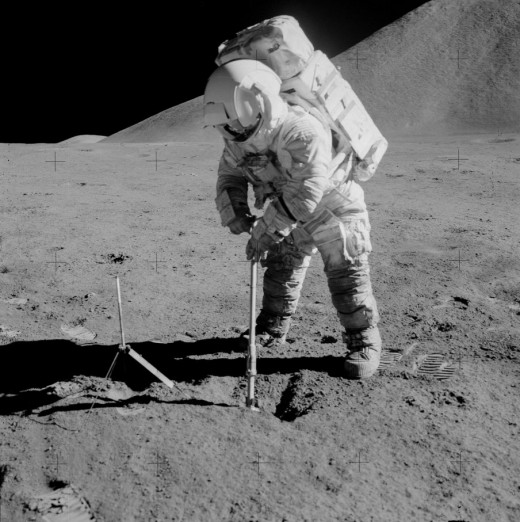
John Young

John Young - Ninth Man on the Moon
John Young was born in 1930 in California and was the 9th man to walk on the moon. He was a member of the 1972 Apollo 16 crew when he earned this distinction. He had previously flown on the Apollo 10 mission in 1696 which was a lunar orbit only flight.
Young had a distinguished career as an astronaut and flew into space a total of 6 times. He has piloted the Gemini spacecraft, the Apollo Command Module, the Lunar Module and the Space Shuttle.
Young earned a degree in aeronautical engineering from the Georgia Institute of Technology in 1952 after which he joined the US Navy. After a tour of duty in the Korean Seas, Young became a fighter and test pilot.
Young joined NASA in 1962.He became the Commander of Gemini 10 and is attributed with successfully completed the first dual rendezvous of spacecraft.
Young was on the crew of the Apollo 10 and flew the first solo flight of the Command Module while the rest of the crew was flying the lunar module around the moon. He became the commander of Apollo 16 and later served as backup commander for Apollo 17.
After the Apollo program ended, Young flew the Space Shuttle twice. He retired from NASA in 2004 after 42 years of service.
John Young Moonwalks
The MoonJump - Apollo 16 Commander John Young jumps and salutes the flag April 20, 1972
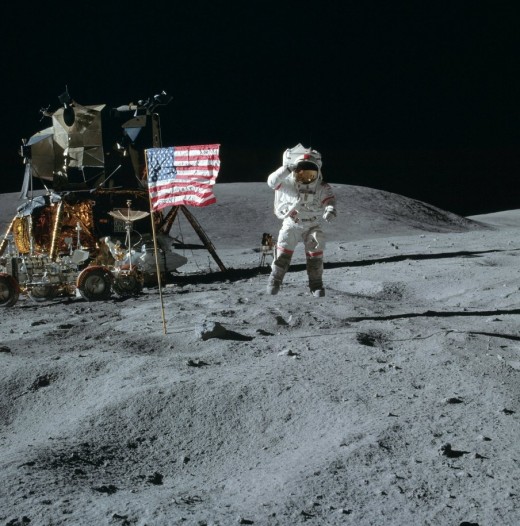
Charles Duke

Charles Duke - Tenth Man on the Moon
Charles Duke was the 10th man to walk on the moon during the 1972 Apollo 16 mission. Born in 1935 in North Carolina, he earned degrees from the US Naval Academy and the Massachusetts Institute of Technology. He joined the US Air Force and went through pilot fighter training. He was a fighter interceptor pilot in Germany for 3 years.
Charles Duke earned the rank of USAF Brigadier General before retiring from the Air Force. He was a member of the Apollo 10 support crew and was the voice of Mission Control during the Apollo 11 flight. On the Apollo 16 mission, Charles Duke was the lunar module pilot. His last Apollo program participation was as a backup lunar module pilot for Apollo 17.
closeup of LRV / Duke

Eugene Cernan

Eugene Cernan - Eleventh Man on the Moon
The 11th man to walk on the moon was Eugene Cernan in 1972 while a member of Apollo 17. He earned the title “last man on the moon” with his lunar walk having been the last person to exit the Lunar Module to the moon’s surface.
Born in 1934 in Illinois, Cernan graduated from Purdue University and then was commissioned in the United States Navy. While in the Navy he earned a graduate degree at the Navy Postgraduate School. He reached the rank of Captain before retiring.
Eugene Cernan flew into space three times on the Gemini 9A, on the Apollo 10 and on Apollo 17. He began his astronaut career with NASA in 1963 and has the distinction of being only one of 3 men who have flown to the moon twice.
In 1976 Eugene Cernan retired from NASA and military duty and entered the world of private business.
The Last Words Spoken on the Moon
The last words spoken by a man standing on the moon were Cernan’s words. As he prepared to leave the moon’s surface he said,
“As we leave the Moon at Taurus-Littrow, we leave as we came, and God willing, as we shall return, with peace and hope for all mankind.
As I take these last steps from the surface for some time to come, I’d just like to record that America’s challenge of today has forged man’s destiny of tomorrow.
Godspeed the crew of Apollo Seventeen.”
Gene Cernan in The Last Moonwalk From Apollo 17
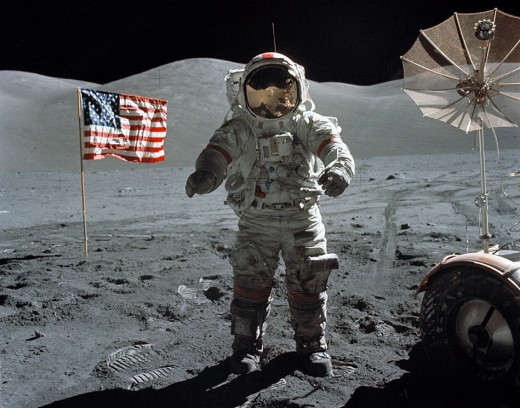
Gene Cernan and Jack Schmitt photographed by Ron Evans during the lunar return trip
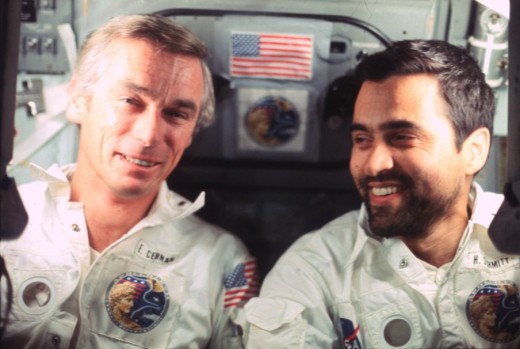
Eugene A. Cernan and Harrison "Jack" Schmitt singing strolling on the moon one day as they walk on the moon during apollo17
Harrison Schmitt

Harrison Schmitt - Twelfth man on the Moon - And Last Man on the Moon
Harrison Schmitt was the 12th and last man to roam the moon’s surface. He was a lunar module pilot on Apollo 17. Cernan was the next to last person to re-enter the Lunar Module followed by Schmidt which is why Schmidt was named the twelfth man to visit the moon.
Born in 1935 in New Mexico, Schmitt was a geologist and a civilian during his tenure as an astronaut. He earned a Bachelor of Science degree from the California Institute of Technology and graduate degrees from Norway’s University of Oslo and the US Harvard University.
Jack Schmitt has worked for the US Geological Survey Astrogeology Center for a while and then joined NASA. He was instrumental in assisting the program with documenting geological results from experiments conducted on the moon.
jack Schmitt resigned from NASA in 1972 and entered the political arena in 1975. He was a one term member of the US Senate representing New Mexico. He is currently the chair of the NASA Advisory Council.
Harrison Schmitt on a Moonwalk
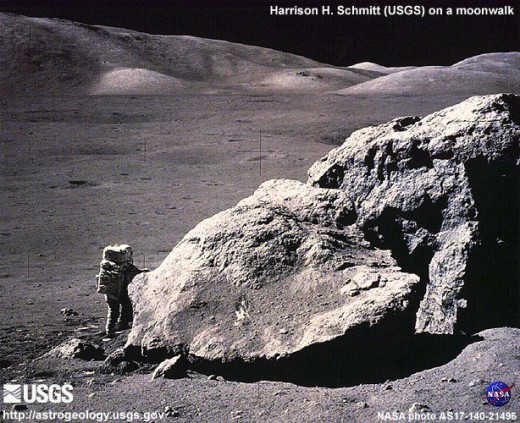
Schmitt stands beside the flag in what is likely the last photograph of an Apollo astronaut on the Moon
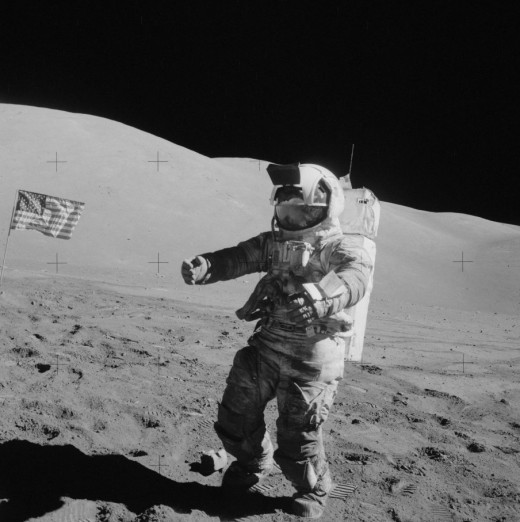
This hub brought to you...
by Julie-Ann Amos, professional writer, and owner of international writing agency www.ExquisiteWriting.com
Why not create your own HubPages? It's fun and you can make revenue from Adsense and other revenue streams on your pages. JOIN HUBPAGES NOW
This work is licensed under the Creative Commons Attribution-Non-Commercial-No Derivative Works 3.0 Unported License. To view a copy of this licence, visit http://creativecommons.org/licenses/by-nc-nd/3.0/ or send a letter to CreativeCommons, 171 Second Street, Suite 300, San Francisco, California94105, USA.
